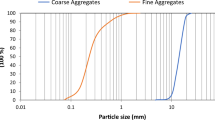Summaries
Concrete may be attacked by different aggressive substances, initiating damaging mechanisms both at the concrete or at the reinforcement. Concrete is mainly attacked by saline solutions, sulphates, freeze-thaw ionic alteration or carbon dioxide. If the carbonation front reaches the reinforcement or if chloride penetrates into the concrete, corrosion of the reinforcement may be initiated. Most of the aggressive substances which are transported into the concrete dissolve in water, mainly through the capillary pores. Also, the corrosion processes are considerably dependent on the moisture content of the concrete.
Supplementary hydrophobic treatments of the concrete surface can be durable and provide a potent method for lowering the moisture content of the concrete, thereby improving its durability by inhibiting the migration of aggressive substances as well as preventing the corrosion process.
At the Institute for Building Materials Research of Aachen University (IBAC), comparative tests have been carried out on the efficiency and long-term durability of different hydrophobic agents on different types of concrete. The applied hydrophobic treatments consist of different chemical compositions, different consistencies and different active solvent contents.
The effectiveness and durability of the hydrophobic treatment was monitored using a multi-ring-electrode sensor that indicates the variation of humidity of the concrete at different depths by measurement of its electrolytic resistance.
Zusammenfassung
Betonbauwerke können durch verschiedene aggressive Substanzen angegriffen und geschä-digt werden. Der Beton wird dabei hauptsächlich durch Salze, Sulfate oder Frost-Tauwechsel geschädigt. Erreicht die Karbonatisierungsfront den Betonstahl oder kommt es zu einem Chlorideindringen in den Beton, wird die Passivschicht des Betonstahls lokal oder großflä-chig zerstört und es kommt zur Bewehrungskorrosion. Der überwiegende Teil der beton- und stahlschädigenden Stoffe dringt gelöst in Wasser über die Kapillarporen in den Beton ein. Der Feuchtegehalt des Betons beeinflußt neben dem Eindringen dieser Stoffe auch die Korrosionsgeschwindigkeit maßgeblich.
Nachträglich aufgebrachte Hydrophobierungen sind eine wirtschaftliche und wirksame Methode, für einen bestimmten Zeitraum den Feuchtegehalt im Beton zu senken und das Eindringen beton- und stahlschädigender Stoffe zu verhindern.
Am Institut für Bautorschung der RWIH Âachen, ibac wurden Untersuchungen zur Leistungstähigkeit und Dauerhaftigkeit verschiedener Hydrophobierungen auf unterschiedlichen Betonuntergründen untersucht. Die dabei eingesetzten Hydrophobierungen unterschieden sich hinsichtlich der chemischen Zusammensetzung, unterschiedlicher Applikationstechniken (Konsistenz) sowie des Wirkstoffgehaltes.
Verwendet wurde dazu ein am ibac entwickelter Feuchtesensor, die sogenannte Multiring-Elektrode. Dieser Sensor erlaubt eine kontinuierliche überwachung der Dauerhaftigkeit und Effektivität, da eindringende Feuchtigkeit sofort tiefenabhängig detektiert werden kann.
Similar content being viewed by others
References
Bürchler D, Der elektrische Widerstand von zementösen Werkstoffen. Modell, Einflußgrößen und Bedeutung für die Dauerhaftigkeit von Stahlbeton. Zürich, Technische Hochschule, Diss, 1996
Raupach M and R Weydert, ‘Bestimmung der Feuchteverteilung in Betonböden mit Einbausensoren, Ostfildern, Technische Akademie Esslingen’, Industrieböden ’99 Internationales Kolloquium, (ed) P Seidler,II, S, 605–10, 12th to 14th January 1999
Schießl P, W Breit and M Raupach, ‘Investigations into the effect of coatings on water distribution in concrete using multi-ring electrodes’, (ed) R E Weyers, S. 119–33, American Concrete Institute, Detroit, ACI SP-151, Concrete Bridges in Aggressive Environments, Philip D Cady International Symposium, Minneapolis, 9th to 10th November 1993
Brameshuber W, M Raupach, P Schröder and C Dauberschmidt, ‘Non-destructive determination of the water content in the concrete cover using the multi-ring electrode’. Deutsche Gesellschaft für Zerstörungsfreie Prüfung, DGZfP, Poster No 41, International Symposium Non-Destructive Testing in Civil Engineering (NDT-CE), Berlin, 16th to 19th September 2003
Raupach M and L Wolff, Dauerhaftigkeit neuer Hydrophobierungen auf Beton, Forschungsberich Nr F 677 Aachen, Institut für Bauforschung, 2002
Raupach M and L Wolff, ‘Investigations on the long-term durability of hydrophobic treatments on concrete’, Farmington Hill, American Concrete Institute, ACI SP-212, Durability of Concrete, S, 409–25, (ed) V M Malhotra, Proceedings of the Sixth International Conference, Thessaloniki, 1st to 7th June 2003
Raupach M and J Brockmann, ‘Effectiveness of polymer-based impregnation agents on natural stones — long-term studies’, Structural Studies, Repair and Maintenance of Historical Buildings VII, (ed) CA Brebbia, S, 161–70, Seventh International Conference, Bologna, 28th to 30th May 2001
Author information
Authors and Affiliations
Corresponding author
Rights and permissions
About this article
Cite this article
Raupach, M., Wolff, L. Long-term durability of hydrophobic treatment on concrete. Surface Coatings International Part B: Coatings Transactions 88, 127–133 (2005). https://doi.org/10.1007/BF02699544
Issue Date:
DOI: https://doi.org/10.1007/BF02699544




